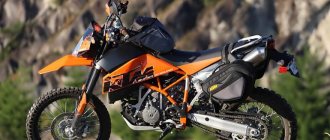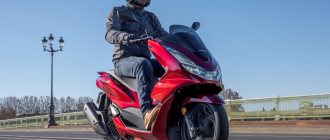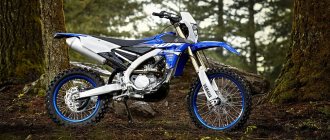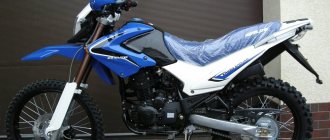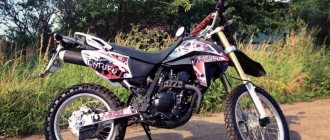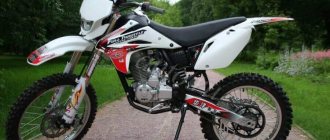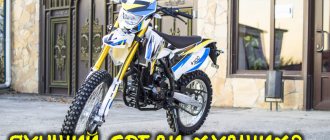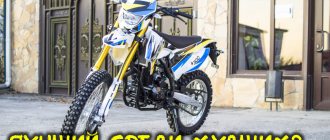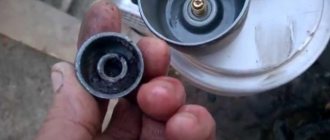Many people, eager to buy an enduro, find it difficult to choose a motorcycle. Having a certain amount of money, people often ask the question: “Which motorcycle should I buy, a new Chinese, an old Japanese or a European enduro?” In this article, as the owner of Chinese and Japanese motorcycles, as well as having close experience with European enduros, namely Beta and KTM, I will try to answer this pressing question.
Content:
- Choosing an enduro motorcycle under 100,000 rubles
- Enduro from 100,000 to 200,000 rubles
- Enduro from 200,000 to 300,000 rubles
- Choice of enduro motorcycle at a price of 300,000 rubles. and more
- There is no difference between Chinese and Japanese motorcycles!
It’s funny, but at the time when I rode a Chinese enduro, they often wrote to me, saying why did you choose a motorcycle from China, it’s much better to take an ancient, but Japanese motorcycle. Then, when I drove an old Japanese car, they pestered me with diametrically opposite statements: “This is a ten-fold Japanese car, it will break down, you won’t find spare parts, and if you do find it, it will be very expensive”... and so on. So it’s almost like choosing a religion, the debate is at least no less heated.
In their own way, both are partly right. In this article, I will try to express my opinion on this matter as fully as possible.
My motorcycles Kayo T2 and Suzuki TS200R
Let's divide motorcycles into several price categories: up to 100 thousand, from 100 to 200 thousand, and from 200 to 300, and from 300 thousand and more.
Rating of the best enduro for beginners
So, you have already collected the required amount of money to purchase a suitable bike. There is no need to rush, because you need to choose an enduro according to your desires and needs. The options that will be presented below will suit all the criteria.
Honda XR 250 Baja
It cannot be confused with similar models - the manufacturer has provided the motorcycle with a large double headlight and a more reliable engine with good lower traction, which will come in handy off-road.
28 hp and a weight of 119 kg is quite a suitable option for a beginner to feel what a real bike is like. But it is hardly suitable for long-distance travel, since it is equipped with a hard and narrow seat, and besides, the loaded rear significantly relieves the load on the front wheel, which does not add comfort.
Equipping the rear suspension with a linkage system allows it to work better than a pendulum. It was this model that conquered the vastness of Altai, the highlands of Tyva and other mountainous areas, where it showed itself excellently.
The cost of a used model will be from 2000 to 5000 USD, and a new one – from 6000 USD.
See the review and test drive of this enduro model:
Yamaha TTR250 Raid
It is a popular version of the “tourist” TT-R 250. It features a large saddle and a tank designed for 400 km. The engine is reliable and simple, air-cooled. Suitable for the metropolis and long difficult hikes. The huge headlight is protected by a frame and shines powerfully.
The suspensions are not as steep as on the Honda, but they are quite suitable for light off-roading, and a beginner does not yet need to jump over obstacles. But you can learn how to drive enduro on it. This model is easy to operate and maneuver. The engine performs well at low and high levels – this is also a plus for beginners. Weighs 120 kg, has a power of 30 hp.
Costs from 1500 to 3500 USD. depending on the mileage traveled. Without mileage it will cost around 4000 USD.
An overview of the characteristics, advantages and disadvantages of the Yamaha TTR250 Raid is presented in this video:
Yamaha XT 250 Serow
Incorporates the best of the XT series - reliability and simplicity. Manufacturers developed this model specifically for difficult off-road conditions. The motorcycle is equipped with a four-stroke engine (air cooling, two-valve head).
The chassis has average suspension travel and a modern half-duplex frame. 20 horsepower, light weight (119 kg) plus great looks and ease of operation - an excellent choice for a beginner. The Yamaha Serow is capable of giving a head start to many off-road bikes, but is not very suitable for long-distance travel.
The cost of a new model can be up to 8,000 USD, and with mileage - from 1,900 to 7,000 USD. depending on the year of manufacture and the number of kilometers driven.
An overview and test drive of this enduro is presented in the following video:
Yamaha WR250R
It has been produced relatively recently, especially when compared with previous models - since 2008. The design is reminiscent of cross-country enduros, which only makes it more attractive. The frame is made of aluminum - this lightens the weight of the motorcycle.
The suspension travel is the same on both sides and is considered one of the most successful among similar models - 27 cm. The rear shock absorbers are perfectly adjustable. The only thing that can be considered a drawback is that it will be difficult for short motorcyclists to control it, because The seat height is 930 mm.
Used models cost from 3500 to 7500 USD, and new ones – from 8000 USD.
For an overview of the main characteristics of the Yamaha WR250R and a test drive of the motorcycle, watch this video:
Choosing an enduro motorcycle under 100,000 rubles
In the price category up to 100 thousand rubles, the choice of motorcycle is clear and there is no alternative, only Chinese enduro. In theory, for this modest money for a motorcycle, you can even find a “purebred” Japanese one, but it will be difficult to call it a motorcycle. Rather, it will be rusty remains of metal and even some kind of plastic, because as we know, polymers do not decompose))) In a word, it will be a complete hemorrhoid, on the restoration of which you will spend a considerable amount, and in any case will go beyond the specified budget. Of course, you can take one, but only if you are a fan of restoring antiquities. But this has a dubious relation to riding a motorcycle. It’s also worth mentioning that Chinese enduro is priced up to 100 thousand rubles. This will be a very entry-level motorcycle. And at this point, you should decide for what purpose you need a motorcycle, for fun rides relatively close to home, or do you prefer tourist outings of several hundred kilometers. I have already touched on this topic a little in the article “The best first motorcycle for a beginner,” I advise you to read it. In short, for rides, I advise you to take the Motoland XT250HS or ZUUM PX220, as they are the most durable, high-quality and generally balanced. If for tourism and comfort, then Motoland Enduro LT, ST or EX.
Motoland XT250HS
Soft (Dual) enduro
These are universal motorcycles for walking outside the city and riding around the city, so to speak, dual-purpose. They do not have any outstanding characteristics. All parts are made for maximum durability and require minimal maintenance. The suspension on the motorcycle is soft; when going over uneven surfaces, you don’t even have to stand up from the seat of the motorcycle.
These are the most popular, economical and inexpensive bikes among their class.
The most common models: Yamaha TTR-250, Suzuki Djeble, Honda XR, Kawasaki KLX.
Enduro motorcycles from 100,000 to 200,000 rubles
At a price of 100 to 200 thousand rubles, you can take mid-level Chinese, which are quite okay. More mature suspensions and brakes are installed here. The engines, although not top-end, have quite reasonable power, which, by the way, are never inferior to their Japanese counterparts, but more on that later. At the lower end of this price segment, in the Chinese camp, motorcycles with a 172FMM engine from Zongshen rule the roost. It is simple, reliable and quite powerful, considering the price of course. This time I will not highlight any specific brand, since for a specific price you can choose motorcycles from different manufacturers that are approximately similar in characteristics and price. You can find out more about enduro motorcycles and more on our website motolifeshop.ru, or consult me about choosing a motorcycle https://vk.com/id33761688, I am open for communication. As for Chinese motorcycles at the top of this segment, there is not much choice. Or Motoland XR250 PRO or again Motoland WRX250 Lite WFA, which I recently took for myself. Oh yes, there is also the Motoland XT250STW. All these motorcycles are united by the Zongshen 170MM-2 engine, which, in fact, is the brother of the 172, but has 4 valves instead of 2 and liquid cooling.
Which enduro should I buy first: 250 or 400 cc?
To understand which enduro and why it is best for a novice motorcyclist to take his first steps, you need to look not only at the purpose of the bike, but also at the engine capacity.
"Soft" (up to 250 cubic meters)
They weigh on average 120 kg. Low weight and dimensions are one of the main advantages in comparison with larger enduros. Relatively inexpensive. They can cope with any suburban conditions, while being maneuverable in a metropolis.
They are not skittish, they will easily forgive some control mistakes, so they are quite suitable for beginners to master driving. A slight rise in the saddle is very useful for short motorcyclists. The engines are simple with one air-cooled cylinder.
Light (250-300 cc)
Perhaps the most popular among Russian motorcyclists are SUVs. The main advantage of the so-called “quarters” is that they are universal and cost less than their cubic counterparts. They are also great for beginners starting out and learning driving skills.
With a low weight, the 250s have good power. They give confidence in city traffic and on the highway, where a reliable and unpretentious single-cylinder engine allows you to rush with a breeze of up to 140 km/h. Thanks to the strong chassis, energy-intensive suspensions and different-sized wheels, it ensures quiet passage of broken country roads and off-road terrain, overcoming ditches, stones, logs, curbs, etc.
A more rigid version also belongs to the same class (250-300). It is distinguished by a sporty bias - stronger suspension, a small gas tank, narrow saddles, and symbolic headlights. This is basically the same cross-country shoe, so it is not recommended for a beginner who does not have good skills to purchase it. Only an experienced motorcyclist can realize all the possibilities of a 300cc hard enduro.
If we consider the destination class, then soft and touring 250 cc enduros may be an ideal option for a beginner. They have a calmer character and almost every novice motorcyclist can ride them without any problems.
"Medium" (400-650 cubic meters)
The class of balanced all-rounders and powerful sports bikes is unlikely to be suitable for beginners - only trained motorcyclists should ride these enduro bikes. Overall, this is an excellent vehicle for daily driving and long-distance driving on any road. On the highway it is more comfortable and quicker to fire than “checks”. They weigh on average 140 kg.
“Heavy” (from 650 cubic meters)
Designed mainly for long journeys on roads and off-road. There are tough variations - successors to the line of the first champions of famous races; There are soft ones - all-terrain vehicles. It is better for beginners not to sit on either one or the other.
Such monsters weigh 1.5-2 centners. In addition to classic single-cylinder engines, among them you can see two-cylinder and V-shaped variations.
Enduro motorcycles from 200,000 to 300,000 rubles
But in the 200-300 thousand category, when it comes to choosing a motorcycle, everything is not at all clear. Here are both top Chinese and Japanese enduros, which are not so old anymore and have very “fun” characteristics. But let's take things in order. On my YouTube channel “Moto Life Enduro ” there are quite a few reviews of top Chinese enduro motorcycles. This is the best that Chinese manufacturers offer. There are modern suspensions, excellent brakes, and powerful engines. In addition, all the advantages described above, such as the easy availability of both the motorcycles themselves and spare parts, have not gone away. Prominent representatives of the class are the ZUUM CX300R and Avantis 300Pro.
Hard enduro
This type is intended for competitions.
They are made from dirt bikes. A dashboard, headlights, and rear brake light were added to them. Engine settings have been changed - maximum power at lower speeds. Transmission with long gears and slightly softer suspension. The motorcycle is a sports motorcycle, so it needs to be maintained constantly, just like a motocross motorcycle. In terms of power-to-weight ratio, hard enduro definitely wins compared to other types. It is the most powerful and lightest of all types in this class.
The main representatives of Japanese brands: Honda CRF250 (450) X, Yamaha WR250 (450) f, Kawasaki KLX450R, Suzuki RMX450Z.
Choice of enduro motorcycle at a price of 300,000 rubles. and more
But at a price of 300+, it’s quite possible to choose a European motorcycle. If you want something fresh, fresh in every sense, then you should add another hundred, or even two, and take a KTM, Husqvarna or, for example, a Sherco. But for 300+ thousand rubles, a European hard enduro will still be far from ideal, but you can find one that is quite lively. A good friend of mine took a KTM EXC350F last year. Yes, it was quite shabby, but over time a friend restored it. Also, for this money it’s already possible to grab a quite “strong” Japanese car, fresh from the year of manufacture. But this time, in all respects, the Europeans will win.
The concept of enduro: where it came from
Enduro comes from the Latin word indurare, which means tireless, persistent, tenacious.
The Enduro class emerged as a result of the International Six Day Trial, a world team six-day cross-country motorcycle competition, held since the beginning of the twentieth century. The purpose of these competitions was to test the strength and identify the best motorcycles of the participating teams. Over time, racing rules and requirements for motorcycles changed. After each race, the teams had to constantly refine the equipment, thanks to which the appearance of enduro motorcycles became unique and today it can no longer be confused with any other class of motorcycle.
There are many types of motorcycles in this class, but we will take three main ones. Let's look into them.
home / Useful / What is “enduro”? — part 2 /Continuation. Started in No. 12/2007
The following review is an attempt to give an express description of used Japanese-made motorcycles of a minimum price niche that enter the Ukrainian market. Taking into account that there is minimal demand for cubic capacity up to 200 cm3, small cubic capacity devices will not be considered in this review. Motorcycles with not yet very common engines and water cooling will be highlighted in the text. If the cubic capacity is not indicated, this means that under this name there is a different-sized “family” of motorcycles.
Sports enduro
If you only want to stir up mud, stir up water and raise columns of dust, then this is your choice. Almost all motorcycles that belong to this “breed” are actually “cross bikes” with a derated engine and headlight to increase their service life. These motorcycles often do not have anything extra, such as an electric starter. It is important to understand that this class is not a choice for beginners! To have a “friendly relationship” with sports enduro, you need to be an experienced off-road pilot. Motorcycles of this class usually do not have “stops” and “turns” (exceptions are “internal Japanese”), so although it can be registered with the MREO, it is not possible to pass a technical inspection and ride on public roads. The fate of its owner is off-road food trucks and transportation on a trailer or by bus to “places of military glory.” This also includes “crazy” two-stroke bikes: Honda CRM and Kawasaki KDX . They have a full set of lighting equipment and can be registered and even driven on public roads. Let the owner decide how justified this step is. Personally, I doubt the “pleasure” that a motorcycle with a particularly evil engine and a cross-style short throttle handle can bring in city traffic jams or “fast” asphalt turns.
There are many four-stroke “250s” in this class: Suzuki DR-Z 250 , Honda XR250R , Yamaha TT250R , Kawasaki KLX250 (“watery”). But sports-tuned rigid suspensions that are unable to handle road unevenness, a small gas tank, narrow and hard sports saddles and symbolic headlights are not a very good combination over more or less significant asphalt distances. These features bring these bikes into this category rather than the next. Despite certain inconveniences, the opportunity to independently travel 200-300 km to the place of future exploits is hard to underestimate. Tourist versions of some of them are more suitable for long-distance raids, but we will talk about them later.
The most popular 400s are the Suzuki DR-Z400E and Yamaha WR (both dropsy). Sports uncompromising projectiles, for off-road use only. If you like one of them, and you are able to realize their capabilities, be prepared to invest money in a motorcycle.
Very rarely, but still sometimes in Ukraine there are “hard” 600s : Honda XR650R (“dropsy”), Yamaha TT600 , Kawasaki KLX600 (“dropsy”). The first of them has such a loaded engine (62 hp) that it requires an oil change after one thousand kilometers (!). The devices are for very experienced drivers. Without regular exercise in the gym, there is no point in approaching the “six hundredth” kickstarter.
Soft enduro, or soft enduro
This “breed” includes motorcycles that manufacturers have tried to adapt for both on-road and off-road use. A truly universal technique, the heir to the scrambler concept of the 1960s, from which (one might say) the history of the enduro class began. However, we “pay” for versatility by the inability to move quickly (rally style) off-road. Let me remind you that speed is a relative concept. Moving at a speed of 60 km/h along a path in an unfamiliar forest (and each of the devices listed below is capable of this), those who wish will receive such an amount of adrenaline that it will not seem like enough.
The “250-k” class is opened by the Yamaha TT-R 230 and XT225 (Serow) and the Honda XL250 Degree (dropsy). In fact, these are not exactly enduro, but almost the only representatives of a rare breed of mountain motorcycles. If you look closely at these devices, trial features will become noticeable - a shortened wheelbase, a large fork offset, a low saddle, and relatively small suspension travel. Another common feature in the transmission is a very short first gear, tuned for mountains. These motorcycles are designed for relatively quiet off-road riding. But trialling or driving several hundred kilometers on asphalt is not a problem for them, and they are very convenient in the city. The XT has a simple and undemanding two-valve air-cooled engine that simply doesn't have anything to break. Its competitor is a kind of Honda factory self-propelled gun: it has a frame from the XR (until ’95), suspension and a modern two-shaft water-cooled engine from the AX-1. “Degree” is a full-fledged two-seater motorcycle, even the passenger’s legs do not interfere with the driver (if both are no more than 175 cm tall - editor’s note).
Also included in this class is the Honda NX250 (dropsy), which was sold in Europe until 1996. With the exception of a frame shared with the "urban Japanese enduro" Honda AX-1, a rally-style body kit and minor gearbox quirks (which consequently made it a less extreme environment), this bike is not much different from the XL250 Degree.
The Honda XR400 is an interesting combination of the compact chassis of the 250 and a high-torque and reliable 400 cc engine, which, even in the mountains, rarely requires a lower gear after third gear. The suspensions are quite weak, most likely designed for a quiet ride rather than off-road use. Despite all this, only domestic Japanese equipment has complete lighting equipment.
Suzuki DR-Z400S (dropsy) is the undisputed leader of the Ukrainian enduro market. An almost perfectly balanced device that allows you not to deny yourself anything off-road and at the same time feel confident on the highway and in the city.
The Honda XR650L doesn't share a single nut with the very similar-named XR650R. A very interesting motorcycle: it has a relatively quiet engine from the Dominator, and at the same time uncompromising suspension from the cross-country CR. The stock version is equipped with a spartan sports body kit. But, given its popularity for travel and long trips, a whole bunch of tuning is made for it - from a more capacious tank and a wide saddle, to Baja-style headlights and luggage systems.
The Yamaha XT600E traces its origins to the legendary winner of the first Dakar, the XT500. It has a simple and reliable, revolver-like engine, which is also installed on the TT600. The rather evil appearance is deceptive - this is a classic touring motorcycle with fairly short travel and soft suspension. But in his role he is unsurpassed! The saddle “in stock” is quite wide and soft, and the problem of a small tank is solved by tuning. of the XT400 Artesia is being manufactured for Japan . It is almost as heavy as the 600, and the engine is one and a half times weaker, so it is not in great demand. However, both 600 and 400 both have great potential for relief. Just replacing standard steel wheel rims with aluminum promises to remove 5-6 kg.
The Honda XR650L and Yamaha XT600 are the favorite motorcycles of adventurers and world travelers. Even the “250-k” is enough for the Japanese who are not complex with large-displacement engines.
Suzuki DR650 , which has much in common in ideology with the XR650L and XT600, more often comes to Ukraine in the “Dakar” version - with a large tank.
The Kawasaki KLR650 (drosy) is a very popular competitor to the XT600 in America. The reputation is controversial; quite often owners have some complaints about the reliability and strength of the chassis and body kit. On the other hand, there are also many completely satisfied owners. The motorcycle is known primarily for the fact that a diesel engine conversion kit is sold for it (!).
Enduro for off-road tourism
This breed was bred in Japan, and is widespread only there. These motorcycles are designed to travel in extremely difficult conditions, even in the complete absence of roads. 250s are best suited for this use, so it’s clear that they exist exclusively in this role. The favorites of Japanese motorcycle travelers have recently gained popularity here.
This “breed” includes a trio of “250-k”, well adapted for autonomous survival in deserted areas. The Honda XR250 Baja and Yamaha TT-R250 Raid are modifications of the “hard” versions. Suzuki XC250 Djebel is designed from scratch. The common features of these motorcycles are larger gas tanks (the Djebel record is 17 liters!), wider and softer saddles. Huge and round headlights (Baja even has two) allow you to move quickly and safely at night. They have slightly softer suspensions compared to the “hard” versions. Baja is more off-road oriented and, accordingly, less comfortable when moving on asphalt. The Raid and Djebel feel much better on the road, but off it they are capable enough to go almost anywhere. But just drive, not race! Raid has a full-fledged, quite comfortable two-seat saddle, which is very rare on 250s.
The Suzuki Djebel 200 stands somewhat separately - a wonderful device that is undeservedly ignored by potential buyers. the DR200, which is completely unknown to us, has a classic engine (with a “wet” sump) with 20 “horses”, a 13-liter tank, which is enough for almost 500 km (!!!) of travel, ideally tuned at the same time for the road, and its lack of suspension and powerful headlight. The perfect first off-road bike, and cheap to run too. It is its engine that the Chinese “clone” in their “200” cars, losing almost 40% of the power in the process.
Heavy enduro
These motorcycles are designed primarily for long-distance travel. Driving with luggage, and possibly with a passenger, does not imply extreme drive. When traveling, safety on the route comes first, because even a minor injury can lead to disruption of the travel schedule, or even its complete cessation. Under these conditions, there is a need for more comfortable suspensions, larger tanks and the ability to have a speed reserve. Also important are the issues of not only the service life of equipment, but also maintenance intervals. Therefore, for travel, models with a large engine capacity are often preferred. Although they are heavier and have less cross-country ability, they are nevertheless true all-rounders. If your route involves both autobahns and caravan trails, you should choose from tourist enduros.
The heirs of rally cars proudly wear an advanced plastic body kit. Although the plastic is not as fragile as on “sports”, nevertheless, it is not able to withstand every fall. Therefore, it is recommended to install roll bars on such motorcycles. They will protect not only the plastic, but also the radiators, engine, tank and other vital components. The tradition of equipping a low front wing comes from rallying - there is no dirt in the Sahara. Thanks to the large base of vehicles, there is plenty of space for passengers and wardrobe trunks. The size also guarantees the respect of car owners: against the backdrop of some R6 “Africa,” for example, it looks quite respectable. But, despite the external similarity with rally motorcycles, the character of the breed is entirely friendly. Having changed their specialty (from rally racing to tourism), these motorcycles became very comfortable.
The breed is divided into two “families” - with one- and two-cylinder engines. The latter are heavier and somewhat more complex, but provide greater smoothness and comfort.
The first includes the Honda NX650 Dominator , Yamaha XTZ660 Tenere (dropsy) and Suzuki Freewind . The legendary Dominator engine has the reputation of being “eternal”. A very balanced vehicle, thanks to its small (by the standards of the breed) weight and dimensions, it is capable of real off-road adventures, although its usual environment is broken roads. Tenere has a water-cooled version of the XT engine, which also has a reputation for being “indestructible.” Thanks to its greater mass and high center of gravity, it can only be controlled by an experienced pilot off-road. "Freewind" is a rare bird among us. The engine from the DR650 gets you out of various troubles well, but the chassis leaves a clear “parquet” impression.
Standing a little apart are two “record” single-cylinder motorcycles from Suzuki: DR750 and DR800 Big . Surprisingly light in comparison with their two-cylinder “colleagues” in cubic capacity, they have additional lightening capabilities and are almost as good as their competitors in power and torque.
The two-cylinder “family” includes the Honda XR750V Africa Twin , XL 600 (650) Transalp and Yamaha XTZ 750 Super Tenere (all “dropsy”). “Africa” is a favorite of motorcycle tourists from the Old World, it “takes” reliability and comfort. Its old 650 cc version is more “hard” than the newer and more common “750”, and accordingly, is slightly inferior to the latter in comfort.
The Honda XL Transalp series in the European version has 600 and 650 cc, in the Japanese version – 400. A reliable motorcycle that can be called a less cc version of the “Africa Twin” with simplified suspensions that are closer to “parquet” use. He is loved for his flexibility and reliability. The V-twin from the chopper pulls quite well throughout the entire range. The 400, given its weight, lacks power, however, it can feel good on the road and even in the forest (if you drive without a passenger and are extremely careful).
“Super Tenere” is a whim of Yamaha, which, it seems, at one time put a “racing” motorcycle on the assembly line, without burdening itself with adaptation to the average motorcycle enthusiast. This is the main difference with “Africa” - the model is less suitable for tourist use. The engine is more powerful than the “African” one, but this is noticeable at high speeds, which is not very good for difficult off-road conditions, and it also increases fuel consumption. The motorcycle has a reputation as a harsh teacher, which requires professional skills, complete dedication and physical strength from the rider. The owner of the “Pimp” (as he is sometimes called in narrow circles), if he meets the requirements of the apparatus, pleasure is guaranteed.
"Parquet" enduro
These motorcycles have reduced suspension travel and ground clearance, often with alloy wheels. The seating position is no longer straight, but rather classic, with a slight tilt forward, which does not imply a change in body position while riding. If you dig deeper, the sportbike origins of the engines often become noticeable. Unlike “parquet” jeeps, which exist solely for show-off, parquet enduros, in my opinion, are not an offensive term. It is the “SUVs” that are able to move the driver and passenger along any kind of broken asphalt at high speed , for which we thank them very much. The appearance of the SUVs is also associated with rally roots. They differ from the previous breed in softer suspensions and, what is much more important, in more road-ready engine characteristics - for high power at the “tops,” the “bottoms” are often sacrificed.
In the “250-k” class, almost the only, but highly rated device is the Honda AX-1 . It has the reputation of being almost an ideal “corkscrew” for city traffic jams. A very successful motor was developed for it, which was also used in the XL250 Degree and NX250. 4 valves, 2 camshafts, water cooling. Even now it’s not often possible to see such a combination on enduro, so what can we say about 1986, when it first appeared? With a weight of 116 kg and a power of 29 hp, the motorcycle can accelerate to hundreds in 6.5 seconds! It has quite a decent passenger seat.
Kawasaki KLE - looks very similar to Transalp. The Japanese version is “400”, the European version is “500”. The engine is of sportbike origin, with all that it implies - there is almost no “lower end”. This annoying circumstance will not cause noticeable inconvenience on a rolled primer, but after rain it is better not to climb onto the ground.
Yamaha XT660 is the successor to the XT600 with the engine from the XTZ660, which changed the environment. Considering that in Europe there are big problems with off-roading, as a result of which most enduros are used exclusively on asphalt, Yamaha created this “road SUV”, mercilessly amputating features unnecessary for asphalt. Although the appearance remains almost classic enduro, it is enough to pay attention to the shape of the front fender, the location of the radiator and the exhaust pipes that run under the engine for the parquet nature of this motorcycle to become obvious.
The Honda XL1000 Varadero and Suzuki DL650/1000 V-Strom are more off-road sportbikes than enduro bikes. Powerful engines and a weight of “over 200 kg” are not the best combination for off-roading, but the ability to quickly and comfortably drive on secondary roads makes these vehicles almost ideal road tourists.
This attempt at systematization is entirely subjective and makes no claims to the completeness and categoricalness of the assessments. If you are concerned about choosing an enduro, do not rely only on any sources of information in magazines and the Internet, including the one you hold in your hands. The most important thing will still be personal acquaintance with the selected device. There are a lot of examples when “love based on photographs” when dating ends in disappointment. And vice versa, sometimes it makes sense to get into the saddle of an unattractive-looking machine in order to understand that this is the very motorcycle you have been looking for for so long.
So, if you want to become the owner of an enduro, then for a successful choice you first need to honestly answer the question to yourself: WHAT will I use it for? Hardcore food trucks, off-road tourism, long-distance driving on roads in any condition, petty urban hooliganism: each purpose requires appropriately adapted equipment. If you want to win something, you need to understand that you will definitely lose somewhere. Remember: there is no such thing as bad technique, just bad choices.
Wishing you paths, and see you in the “pampas”!
Text: Alexey Pilipenko, Andrey Kisel Photo: from the archive of the editorial office of MotoDrive No. 1, 2008
